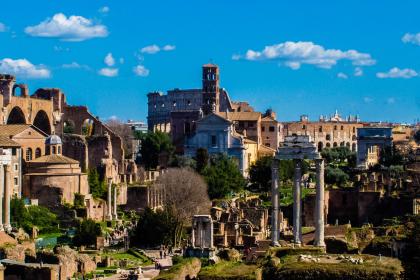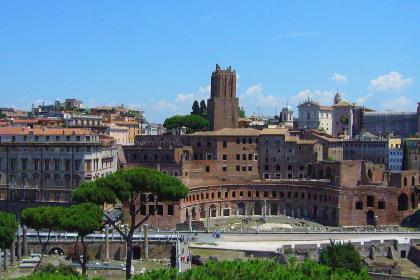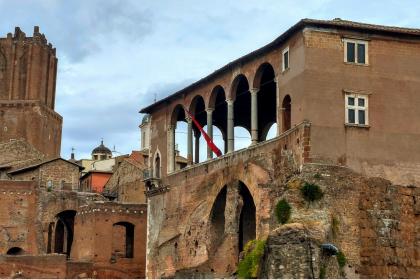
A fine example of medieval Rome’s tower-houses, residences and fortresses built by noble families and ecclesiastical authorities , the Torre dei Conti overlooks Largo Corrado Ricci (named after the general director of Antiquities and Fine Arts during the excavations of “via dell'Impero”), which took the place of the old “piazza delle Carrette”, a toponym descending from the horse-drawn carriages that stopped here, on the edge of the Roman Forum, at the time a market area.
Mentioned even by poet Francesco Petrarca in his letters and also known as Torre Maggiore or Torre Secura, due to its size and its impregnability, it was built on the ruins of one of the four exedras of the Templum Pacis, perhaps as early as the 9th century. In 1203, based on a design by the architect Marchionne Aretino, the tower was certainly enlarged by Pope Innocent III for his family, the Counts of Segni, and covered in travertine salvaged from the Imperial Fora, then removed in the late 16th century on the occasion of the construction of Porta Pia. In the intentions of the pontiff, the tower was to represent the ecclesiastical power and protect the papal processions papal processions that moved toward the major basilicas.
Originally, the base of the tower was up to 50-60 metres high. Its current state is the result of a long series of events: repeatedly shaken by earthquakes throughout its history, especially those of 1348, 1630, and 1644, the tower had a period of rebirth at the end of the 17th century, when it underwent major restoration under the pontificate of Alexander VIII. In the following centuries, the tower, dilapidated and abandoned, was used as a barn and as a coal depot. The demolitions carried out between the late 19th century and the 1930s for the opening of Via Cavour and the current Via dei Fori Imperiali led to its isolation and the destruction of the maze of narrow streets that surrounded it. On 3 November 2025, the tower, which had been closed since 2007, suffered a significant internal collapse during restoration and refurbishment work on the structure.
Archaeological area of the Imperial Fora

 Condividi
Condividi
Torre delle Milizie - Tower of the Militia

 Condividi
Condividi
House of the Knights of Rhodes

 Condividi
Condividi
Information
CLOSED
 Condividi
Condividi
Location
To find out about all accessibility services, visit the Rome accessible section.











































